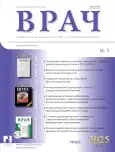Biomimetic collagen-carragenan scaffold for non-drug stimulation of tissue regeneration
- Authors: Markov P.A.1, Rozhkova E.A.1, Eremin P.S.1
-
Affiliations:
- National Medical Research Center of Rehabilitation and Balneology
- Issue: Vol 36, No 3 (2025)
- Pages: 88-93
- Section: From Practice
- URL: https://bakhtiniada.ru/0236-3054/article/view/286928
- DOI: https://doi.org/10.29296/25877305-2025-03-17
- ID: 286928
Cite item
Abstract
Objective. To evaluate the mechanical strength, biodegradability and biocompatibility of composite hydro- and xerogels made from hydrolyzed type I collagen and kappa-carrageenan.
Materials and methods. Using the TA.XTplus texture analyzer, the strength of composite hydro- and xerogels, as well as the intensity of their biodegradation in acidic, neutral and alkaline environments, were estimated. Using light and fluorescence microscopy, the morphometric characteristics of human fibroblasts and their proliferative activity were estimated.
Results. It was found that carrageenan in the hydrogel increases the strength of the structure. Lyophilization of the G4C4-Hydro composite hydrogel allows obtaining a biomaterial with improved mechanical characteristics and increased resistance to destruction in acidic, neutral and alkaline salt solutions. It was found that the G4C4-Hydro and G4C4-Xero samples do not have an inhibitory effect on fibroblast proliferation. It was found that, unlike hydrogel, xerogels not only support fibroblast adhesion on their surface, but also provide favorable conditions that keep fibroblasts viable.
Conclusion. The composite xerogel G4C4-Xero containing hydrolyzed type I collagen and kappa-carrageenan can be used both as an extracellular scaffold for creating tissue-engineering structures and as an independent biomaterial for filling the volume of tissue lost as a result of surgery or injury.
Full Text
##article.viewOnOriginalSite##About the authors
P. A. Markov
National Medical Research Center of Rehabilitation and Balneology
Author for correspondence.
Email: p.a.markov@mail.ru
ORCID iD: 0000-0002-4803-4803
SPIN-code: 7493-5203
Candidate of Biological Sciences
Russian Federation, MoscowE. A. Rozhkova
National Medical Research Center of Rehabilitation and Balneology
Email: p.a.markov@mail.ru
ORCID iD: 0000-0002-2440-9244
SPIN-code: 1578-6338
Biol. D.
Russian Federation, MoscowP. S. Eremin
National Medical Research Center of Rehabilitation and Balneology
Email: p.a.markov@mail.ru
ORCID iD: 0000-0001-8832-8470
SPIN-code: 8597-6596
Russian Federation, Moscow
References
- Nasiri N., Haghdoost F., Habibi M. et al. Stem Cell Perspective for Regenerative Wound Healing: from Biology toward Future Clinical Directions: A Review. Cell Journal. 2025; 26 (10): 575–89. doi: 10.22074/cellj.2024.2034492.1613
- Pourjavadi A., Doroudian M., Ahadpour A. et al. Injectable chitosan/κ-carrageenan hydrogel designed with au nanoparticles: A conductive scaffold for tissue engineering demands. Int J Biol Macromol. 2019; 126: 310–7. doi: 10.1016/j.ijbiomac.2018.11.256
- Liu S., Yu J.-M., Gan Y.-C. et al. Biomimetic natural biomaterials for tissue engineering and regenerative medicine: new biosynthesis methods, recent advances, and emerging applications. Mil Med Res. 2023; 10 (1): 16. doi: 10.1186/s40779-023-00448-w.
- Amirrah I., Lokanathan Y., Zulkiflee I. et al. A comprehensive review on collagen type I development of biomaterials for tissue engineering: from biosynthesis to bioscaffold. Biomedicines. 2022; 10 (9): 2307. doi: 10.3390/biomedicines10092307
- Gu L., Shan T., Ma Y. et al. Novel Biomedical Applications of Crosslinked Collagen. Trends Biotechnol. 2019; 37 (5): 464–91. doi: 10.1016/j.tibtech.2018.10.007
- Farshidfar N., Iravani S., Varma R.S. Alginate-Based Biomaterials in Tissue Engineering and Regenerative Medicine. Marine Drugs. 2023; 21 (3): 189. doi: 10.3390/md21030189
- Klarak J., Brito A., Moreira L. et al. Using network analysis and large-language models to obtain a landscape of the literature on dressing materials for wound healing: The predominance of chitosan and other biomacromolecules: A review. Int J Biol Macromol. 2025; 26: 141565. doi: 10.1016/j.ijbiomac.2025.141565
- Pacheco-Quito E.M., Ruiz-Caro R., Veiga M.D. Carrageenan: Drug Delivery Systems and Other Biomedical Applications. Marine Drugs. 2020; 18 (11): 583. doi: 10.3390/md18110583
- Yegappan R., Selvaprithiviraj V., Amirthalingam S. et al. Carrageenan based hydrogels for drug delivery, tissue engineering and wound healing. Carbohydr Polym. 2018; 198: 385–400. doi: 10.1016/j.carbpol.2018.06.086
- Wolf M.T., Daly K.A., Brennan-Pierce E.P. et al. A hydrogel derived from decellularized dermal extracellular matrix. Biomaterials. 2012; 33 (29): 7028–38. doi: 10.1016/j.biomaterials.2012.06.051
- Drobnik J., Pietrucha K., Piera L. et al. Collagenous scaffolds supplemented with hyaluronic acid and chondroitin sulfate used for wound fibroblast and embryonic nerve cell culture. Adv Clin Exp Med. 2017; 26 (2): 223–30. doi: 10.17219/acem/62835
- Jiang D., Rinkevich Y. Scars or Regeneration? Dermal Fibroblasts as Drivers of Diverse Skin Wound Responses. Int J Mol Sci. 2020; 21 (2): 617. doi: 10.3390/ijms21020617
- Katoh K. FAK-Dependent Cell Motility and Cell Elongation. Cells. 2020; 9 (1): 192. doi: 10.3390/cells9010192
Supplementary files















